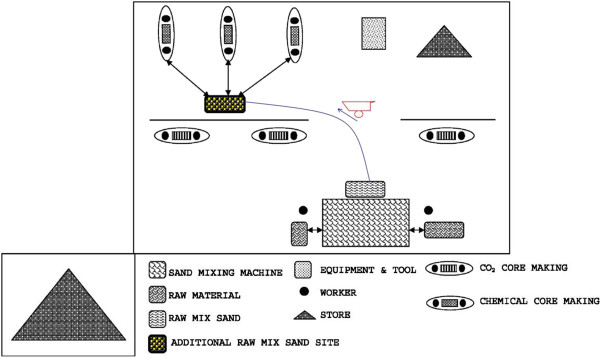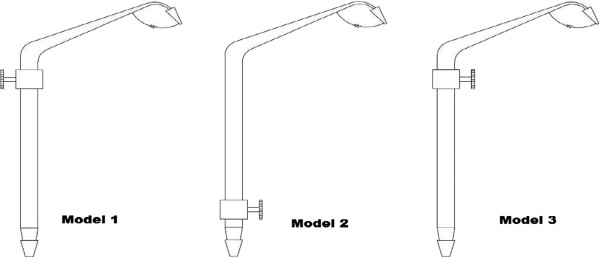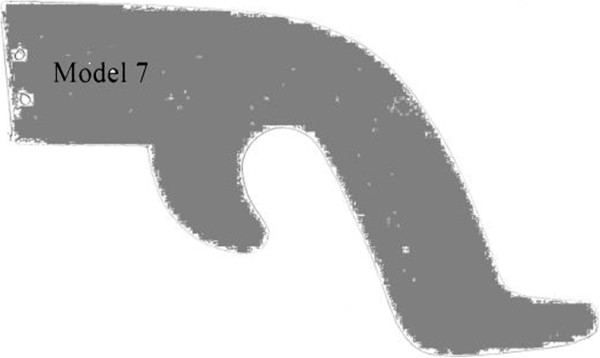Articles
- Page Path
- HOME > Ann Occup Environ Med > Volume 26; 2014 > Article
- Case Report Design and Evaluation of Ergonomic Interventions for the Prevention of Musculoskeletal Disorders in India
- Somnath Gangopadhyay1, Samrat Dev1
-
Annals of Occupational and Environmental Medicine 2014;26:18.
DOI: https://doi.org/10.1186/2052-4374-26-18
Published online: July 1, 2014
1Occupational Ergonomics Laboratory, Department of Physiology, University College of Science & Technology, University of Calcutta, 92 APC Road, Calcutta 700009, India
Copyright © 2014 Gangopadhyay and Dev; licensee BioMed Central Ltd.
This is an Open Access article distributed under the terms of the Creative Commons Attribution License (http://creativecommons.org/licenses/by/4.0), which permits unrestricted use, distribution, and reproduction in any medium, provided the original work is properly credited. The Creative Commons Public Domain Dedication waiver (http://creativecommons.org/publicdomain/zero/1.0/) applies to the data made available in this article, unless otherwise stated.
Abstract
-
Background Improper workstation, work procedures and tools are found to be the risk factors for the development of musculoskeletal disorders among the informal sector workers of the developing countries. Low cost ergonomic interventions can effectively improve such adverse conditions.
-
Case presentation In the present article some studies related to design interventions in different informal and agricultural sectors were discussed and their efficacies were analyzed. It was observed that with the help of appropriate interventions musculoskeletal disorders were reduced, adverse physiological conditions were improved when awkward postures were corrected and ultimately the organisational productivity was increased.
-
Conclusion Proper implementation of ergonomic interventions can ultimately improve the economy of the nation.
Background
Case presentation
| Authors and sectors |
Before intervention |
After intervention |
||||||||||||||
|---|---|---|---|---|---|---|---|---|---|---|---|---|---|---|---|---|
| MSD |
Physiological parameters |
Implication of intervention | MSD |
Physiological parameters |
Evaluation of intervention |
|||||||||||
| HR | PHR | EE | TCCW | PCW | REP | HR | PHR | EE | TCCW | PCW | REP | |||||
|
Gangopadhyay et.al[4] Sand Core Making |
✓ |
|
|
|
|
|
|
✓ |
✓ |
|
|
|
|
|
|
✓ with increase in productivity |
|
Ghosh and Gangopadhyay [5] Jewellary |
✓ |
✓ |
|
|
|
|
|
✓ |
✓ |
✓ |
|
|
|
|
|
✓ |
|
Gangopadhyay and Chaudhury. Ergonomic modification of handle of hand saw used by the Indian carpenters (unpublished) Furniture Manufacturing |
✓ |
|
|
|
|
|
|
✓ |
✓ |
|
|
|
|
|
|
✓ with increase in productivity |
|
Bhattacharyya and Chakrabarti, [6] Agriculture |
✓ |
✓ |
✓ |
✓ |
✓ |
✓ |
✓ |
✓ |
✓ |
✓ |
✓ |
✓ |
✓ |
✓ |
✓ |
✓ |
|
Kishtwaria and Rana, [7] Agriculture |
✓ |
✓ |
✓ |
✓ |
✓ |
✓ |
✓ |
✓ |
✓ |
✓ |
✓ |
✓ |
✓ |
✓ |
✓ |
✓ |
| Chaturvedi et.al[8] Agriculture | ✓ | ✓ | ✓ | ✓ | ||||||||||||
Implementation of the ergonomic interventions at sand core sector
Implementation of the ergonomic interventions at gold smith sector
Implementation of the ergonomic interventions at carpentry sector
Implementation of the ergonomic interventions at agriculture (Tea planting) sector
Implementation of the ergonomic interventions at agricultural sector during weeding activity
Implementation of the ergonomic interventions at agricultural sector during activities with power tiller
Conclusion
Consents
Competing interests
Authors’ contributions
- Herberta R, Dropkina J, Warrenb N, Sivinc D, Doucettea J, Kelloggd L, Bardine J, Kassf D, Zoloth S: Impact of a joint labor-management ergonomics program on upper extremity musculoskeletal symptoms among garment workers. Appl Ergon 2001;32:453–460. 10.1016/S0003-6870(01)00024-2. 11534790.ArticlePubMed
- Van der Molen HF, Kunst M, Kuijer PFM P, Frings-Dresen MHW: Evaluation of the effect of a paver’s trolley on productivity, task demands, workload and local discomfort. Int J Ind Ergon 2011;41:59–63. 10.1016/j.ergon.2010.11.002.Article
- Das B, Shikdar AA, Winters T: Workstation redesign for a repetitive drill press operation: a combined work design and ergonomics approach. Hum Factors Ergon Manuf 2007;17:395–410. 10.1002/hfm.20060.Article
- Gangopadhyay S, Das T, Ghoshal G, Ghosh T: Work organization in sand core manufacturing for health and productivity. Int J Ind Ergon 2006;36:915–920. 10.1016/j.ergon.2006.06.011.Article
- Ghosh T, Gangopadhyay S: Effect of an ergonomic intervention on muscle fatigue and respiratory stress of goldsmiths during blowing pipe activity in India. Work 2012;43(4):427–435. 22976167.ArticlePubMed
- Bhattacharyya N, Chakrabarti D: Ergonomic basket design to reduce cumulative trauma disorders in tea leaf plucking operation. Work 2012;41:1234–1238. 22316888.ArticlePubMed
- Jatinder Kishtwaria J, Rana A: Ergonomic interventions in weeding operations for drudgery reduction of hill farm women of India. Work 2012;41:4349–4355. 22317388.ArticlePubMed
- Chaturvedi V, Kumar A, Singh JK: Power tiller: vibration magnitudes and intervention development for vibration reduction. Appl Ergon 2012;43:891–901. 10.1016/j.apergo.2011.12.012. 22264876.ArticlePubMed
REFERENCES
REFERENCES
Figure & Data
REFERENCES
Citations

- Ergonomic Evaluation of Conventional Rural Flour Mills in India: Challenges and Recommendations
Kishor Gawande, Somdatta Tondre, Niraj Raja, Rajesh Pokale, H. Liu, T.A. Tran, P.M. Jawandhiya, M. Ghonge
EPJ Web of Conferences.2025; 328: 01058. CrossRef - General Guidelines for Utensil/Clothes Washing Workstation to Reduce Risk of Musculoskeletal Disorders Among Indian Domestic Workers
Somdatta Tondre, Rajesh S. Pokale, Kishor R. Gawande, Niraj N. Raja, H. Liu, T.A. Tran, P.M. Jawandhiya, M. Ghonge
EPJ Web of Conferences.2025; 328: 01067. CrossRef - Assessment and evaluation of work-related musculoskeletal disorders among nuclear medicine professionals in India: A cross-sectional study
Sam Blessing Viniston J, Shivanand Bhushan, Shovan Saha, Karen Jacobs, Remko Soer
Work.2024; 78(1): 207. CrossRef - A Review of Potential Exoskeletons for the Prevention of Work-Related Musculoskeletal Disorders in Agriculture
Sanura Dunu Arachchige, Lasitha Piyathilaka, Jung-Hoon Sul, D. M. G. Preethichandra
Sensors.2024; 24(21): 7026. CrossRef - Assessment of Posture Related Risks among Goldsmiths Using Rapid Upper Limb Assessment (RULA) and Rapid Entire Body Assessment (REBA)
Debabrata Bera, Sayan Sarkar, Bivash Mallick, Manik Chandra Das
Journal of The Institution of Engineers (India): Series C.2024; 105(5): 1311. CrossRef - Predicting Human Postures for Manual Material Handling Tasks Using a Conditional Diffusion Model
Liwei Qing, Bingyi Su, Sehee Jung, Lu Lu, Hanwen Wang, Xu Xu
IEEE Transactions on Human-Machine Systems.2024; 54(6): 723. CrossRef - Development of an Ergonomic, Portable, Climber-Propelled Date Tree Climbing Device
Maryam Rafiee, Mohsen Razeghi, Alireza Choobineh, Mehdi Jahangiri, Mozhgan Seif
Journal of Agromedicine.2023; 28(3): 497. CrossRef - Efforts to Control Work Environment Hazards Based on 5S Principles for Smoked Fish Workers
Yuliani Setyaningsih, Ekawati Ekawati, Ida Wahyuni, M.I. Kartasurya, N. Lisnawati, A.F. Asna, N. Handayani, D.Z. Nuridzin
BIO Web of Conferences.2022; 54: 00006. CrossRef - A Female Hair Clip and Orthodontists’ Neck-Back Pain Perception: A Survey
Arkan Muslim Al Azzawi, Hasan Sabah Hasan, Mohammed Nahidh, Mohamed Elkolaly, Ayshan Kolemen, Sivakumar Nuvvula
International Journal of Dentistry.2021; 2021: 1. CrossRef - Prevalence of self-reported musculoskeletal disorders of the hand and associated conducted therapy approaches among dentists and dental assistants in Germany
Yvonne Haas, Antonia Naser, Jasmin Haenel, Laura Fraeulin, Fabian Holzgreve, Christina Erbe, Werner Betz, Eileen M. Wanke, Doerthe Brueggmann, Albert Nienhaus, David A. Groneberg, Daniela Ohlendorf, Sıdıka Bulduk
PLOS ONE.2020; 15(11): e0241564. CrossRef - Low cost ergonomic interventions to reduce risk factors for work related musculoskeletal disorders during dairy farming
Hamidreza Mokarami, Sakineh Varmazyar, Reza Kazemi, Sayed Mohammad Taghavi, Lorann Stallones, Hossein Marioryad, Faramarz Farahmand
Work.2019; 64(2): 195. CrossRef - The prevalence of occupational health-related problems in dentistry: A review of the literature
Rajeshree Moodley, Saloshni Naidoo, Jacqueline van Wyk
Journal of Occupational Health.2018; 60(2): 111. CrossRef - Electromyographic analysis of an ergonomic risk factor: overhead work
Gulsah Kinali, Sadık Kara, Mustafa Selman Yıldırım
Journal of Physical Therapy Science.2016; 28(6): 1924. CrossRef



Figure 1
Figure 2
Figure 3
| Authors and sectors | Before intervention | After intervention | ||||||||||||||
|---|---|---|---|---|---|---|---|---|---|---|---|---|---|---|---|---|
| MSD | Physiological parameters | Implication of intervention | MSD | Physiological parameters | Evaluation of intervention | |||||||||||
| HR | PHR | EE | TCCW | PCW | REP | HR | PHR | EE | TCCW | PCW | REP | |||||
| Gangopadhyay et.al[4] Sand Core Making | ✓ | | | | | | | ✓ | ✓ | | | | | | | ✓ with increase in productivity |
| Ghosh and Gangopadhyay [5] Jewellary | ✓ | ✓ | | | | | | ✓ | ✓ | ✓ | | | | | | ✓ |
| Gangopadhyay and Chaudhury. Ergonomic modification of handle of hand saw used by the Indian carpenters (unpublished) Furniture Manufacturing | ✓ | | | | | | | ✓ | ✓ | | | | | | | ✓ with increase in productivity |
| Bhattacharyya and Chakrabarti, [6] Agriculture | ✓ | ✓ | ✓ | ✓ | ✓ | ✓ | ✓ | ✓ | ✓ | ✓ | ✓ | ✓ | ✓ | ✓ | ✓ | ✓ |
| Kishtwaria and Rana, [7] Agriculture | ✓ | ✓ | ✓ | ✓ | ✓ | ✓ | ✓ | ✓ | ✓ | ✓ | ✓ | ✓ | ✓ | ✓ | ✓ | ✓ |
| Chaturvedi et.al[8] Agriculture | ✓ | ✓ | ✓ | ✓ | ||||||||||||
HR: Heart Rate; PHR: Peak Heart Rate; EE: Energy Expenditure; TCCW: Total Cost of Cardiac Work; PCW: Physiological Cost of Work; REP: Rating scale of Perceived Exertion.
 KSOEM
KSOEM




 Cite
Cite

